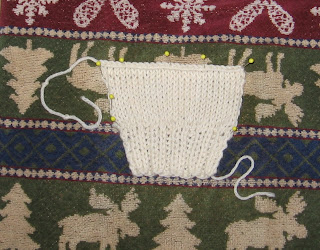These swatches I'm calling mini-swatches. They aren't the size for Swatch I at all. I've knit them for three reasons, choosing yarn and choosing needle size plus improving on edge stitches. The Basics, Basics, Basics swatches were all knit with Lion Brand FISHERMEN'S WOOL and Boye #8 circular. The problem with the swatches were that they had absolutely no body out of the bath and onto the blocking towel. Plus, there was an occasional slub or knot in the yarn.

This is the third mini-swatch which is Lion Brand FISHERMEN'S WOOL, Boye circular #7.

Here is Swatch #2 with Cascade 220 in Natural, Boye circular #7.

The final swatch is Cascade 220 in Natural, Boye circular #9.

All together, they look like this while blocking.
I also tried 16", #8 straights, all frogged.
The edge stitches may not be looked at closely, but I was uncomfortable with how mine had started to appear. I had to discover why it seemed they were twisted as they were. It appears the weight of the needles either by the end of the straights or the weight of the yarn on the one end of the circular needle was causing the strangeness.
After the blocking and the swatches drying overnight, they were ready to be checked for gauge. Yesterday I measured and ran the calculations. The swatches appear to me to be of good gauge for my purposes (but I have been wrong before). They do not match the ball bands.
Speaking of ball bands, the Lion Brand says it is made in China. Cascade 220 does not have a country other than it is Peruvian Highland Wool, which could be anything.
I'd appreciate comments on the various swatches as to one that looks best.
Yesterday wsas also the day to check the cabinet downstairs where I have some books and magazines stored. There's a blocking report due in Level I along with other reports in the other levels. I got out one book and several magazines, starting notes for the blocking report last night.
4 comments:
I see the difference in overall size on the swatches, but looking at the fabric I can't see that much. I'd say go by how it feels - body vs drape for what they want you to do with them.
Also, for the purposes of Level 1, make sure your gauge is in the usual range for worsted weight. It doesn't have to match the ball band, but it does have to be in the range "recommended" by the Yarn Standards.
You might want to swatch a seed stitch too before making your final decision on yarn and needles. There are several swatches that have to be knit with the same yarn and needles, including the seed stitch swatch.
I had to go down a needle size to get a good-looking seed stitch.
I recommend that when you start your real swatches that you start with seed stitch. It might keep you from having to re-knit the swatches that have to be the same needles and yarn. Ask me how I know.
MK2008
well, silly me, i, having absolutely NO technical expertise and just go by observation since i cannot feel the swatches the way i would a fleece before spinning it, i just like the balance of #1 - the stitch size seemed to blend w/the yarn nicely. guess i'd better just sit down and listen to the more educated knitters opines.
For another opinion, I think the fabric should match the item being made. Guage given in a pattern is so your will look like the picture. It seems that the Lion is not as thightly spun as the other and that would affect the end product. The guage given on a band is a suggestion only or a staring point for the knitter. Swatch 1 seems to reflect the yarn and it nature of a softer more open yarn, The other two seem to be a tighter knit and from what I can see of the yarn that would be in the end product. In the new number system which is suppose to help you exchange yarns it is amazing to copmare the yarns or see the difference based on the material it is made of and the manufacture.
Post a Comment